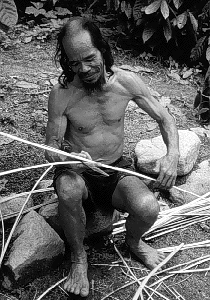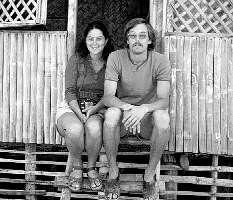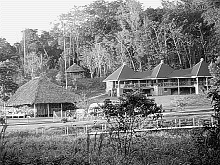SPRING 1998
Volume 15, Number 3
Dodging Pigs and Raising Cane
Managing Forests in Indonesia
by Patrick Hutchins
Photos by Steve Siebert
 |
| A member of the Uma peeling rattan. |
The Lariang River flows fast and muddy down from the spine of Sulawesi, the large Indonesian island just to the east of Borneo. In less than ninety miles, it travels from 8,000-foot peaks in the interior to sea level, carrying the more than two meters of rain that falls each year. Along the way it passes through the village of Moa, where this summer scientists led by husband and wife team Steve Siebert and Jill Belsky will continue their study of a special climbing palm. It is the palm that produces the rattan cane that is found in your rocking chair or your grandmother’s antique couch.
Moa also is home to the Uma, one of at least fifty indigenous peoples who live on the island. The Uma grow rice in the river bottoms, coffee and cacao in the shaded understory of the nearby forest. And they gather rattan, venturing into the rain forest to cut the canes of this supple, climbing palm from its host trees. Lashed together in bundles, the cane is floated down the Lariang to be sold to Chinese traders, who then ship it to Java’s furniture factories. Rattan provides needed cash to the Uma’s subsistence economy, but it’s a multibillion dollar industry for Indonesia as a whole. Anything that endangers the forest will further imperil the country’s already shaky economy, to say nothing of the Uma’s traditional way of life.
Community-based Conservation
As they have every year since 1993, Siebert, an associate professor of forestry and Belsky, an associate professor of sociology at The University of Montana, will be working this summer to develop a new environmental paradigm called community-based conservation. Using techniques they’ve honed in more than twenty years in Indonesia and Central America, Siebert and Belsky are trying to find middle ground between preservationists and developers by identifying ways for people who live in the rain forest to prosper while maintaining the forest’s ecosystem.
 |
| Jill Belsky and Steve Siebert. |
At its simplest, community-based conservation recognizes that people, too, are a vital part of any ecosystem. In Moa, for example, where the boundary of the recently established Lore Lindu National Park now separates the Uma from the rattan they’ve always depended on, Siebert and Belsky are looking at whether permitting rattan gathering in the park might actually contribute to the overall health of both the people and the forest.
A Rain Forest Lab
In Moa, Siebert, Belsky and their ten-year-old son, Max, start the day early with bowls of rice and BBC news on the shortwave radio. Then the work begins. While Max invents stick games with the village children, Siebert and Belsky head out, each pursuing particular research projects in the area.
Siebert’s work takes him on long treks through dense forests, complete with wild pigs, monkeys, swallowtail butterflies and blood-sucking leeches. Or to one of the nurseries he has established where he cultivates rattan palms for future transplant to the forest.
Always, he’s looking for ways to balance the people’s need to make a living and the need to protect the rain forest from the overharvesting that could eventually wipe out the rattan palms. “Given the rate now, which is totally out of control,” Siebert says, “it’s possible that all cane of harvestable length could be collected. That would be tragic.”
Siebert collaborates with Indonesian scientists including Dr. Johanis Mogea, a world authority on rattan. This international collaboration is practical and philosophical. Solutions, Siebert believes, are rarely successful when imposed by outsiders; everyone must have a stake or it will probably fail. “If communities have a harvestable, sustainable product that’s adding to people’s livelihood, you’ve got a strong incentive to maintain a forest,” he observes. “If you prohibit [harvesting] or overexploit the forest, you’ve lost.
“One of our long-term goals, is to recommend that areas of the park be set aside so people from the
 |
|
Earlier this spring Siebert and Belsky led thirteen students on a two-week tour of Belize. Travel poster images to the contrary, the students were in Belize to get fieldwork experience in ecology and sociology. Launched six years ago with a grant from the U.S. Agency for International Development, the program helps students, who collect data and interview indigenous people, understand the problems of equitable development in a Third World country. Belize was chosen because as the former British Honduras, the population is primarily English-speaking, which makes research easier. And despite the heat, humidity, biting insects and the cost (on top of tuition, students must pay $1,500), there is a waiting list to get on the trip. Belsky stresses the importance of moving “teaching into the field.” The students go to three different protected areas and, after studying the ecology and how people make a living from the land, she says they have to come up with interdisciplinary management plans. The program is also a chance for students to spend time with Siebert and Belsky, away from harried academic schedules. “It’s a chance to have those hour and a half conversations with students about what their life goals are.” says Belsky. “The program has literally changed lives.” |
Finding Solutions That Work
Meanwhile Belsky investigates how the people of Mao or other regional villages relate to the land and what their attitudes are toward the social and economic changes overtaking them. Many times, Belsky observes, it’s the “poorest of the poor” who use the forest most. “[Harvesting rattan] is arduous work, the canes have sharp thorns and sometimes bees’ nests get pulled down,” she says. “Female heads of households will take their sons out there to get what some people call ‘nature’s subsidy.’”
Among the many language and religious groups (the Uma, perhaps surprisingly, are Christian) living on Sulawesi, she is looking for ways to resolve the conflict between community and conservation. “I’m trying to find out if there are traditions we can build into park management plans that are community-based and community-run so that they have a better chance of success,” Belsky says. “The local communities manage these forests through their choice of what plants to keep, what plants to eat, what fruits to plant. This is seldom recognized by outsiders.”
Clearly, Siebert and Belsky face an enormous task, not made any easier by the political turmoil currently rocking the Indonesian government. Yet its importance has been recognized and supported by the Indonesian scientists with whom they work, by The Nature Conservancy and USAID, which has picked up their grant through the year 2000. And, most significantly, by the people of Moa, whose initial distrust has turned into a friendly welcome each summer.
Community-based conservation may one day be the way we all think about our environment. “I’m constantly in awe of the love that these people have of place, which parallels many folks in Montana,” Belsky says. “They are struggling to be able to stay in their place the way they know it and love it and still make a living. These same struggles are going on all around the world.” M
Patrick Hutchins is a free-lance writer in Missoula.